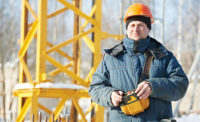Heat-related illnesses claim the lives of over 650 people in America each year, and yet they are all largely preventable. Two of the most common and concerning heat-induced illnesses to plague workers are heat exhaustion and heat stroke. While both can be prevented by wearing cooling clothing for work, drinking ample water, and taking frequent breaks, they nonetheless lead to thousands of cases each year.
In this guide, we’re going over these two common yet concerning heat-related conditions to help ensure that you and those around you stay safe on the job. Being able to identify the distinct signs and symptoms of each of these two conditions is crucial to mounting a proper response. And, in the case of heat-induced illness, a proper response can mean the difference between life and death.
Heat stroke is a medical emergency. If you believe that you or someone you know is suffering from heat stroke, call 911 immediately.
Heat Exhaustion
Heat exhaustion is the less serious of these two heat-related illnesses, but it’s still something you can’t afford to ignore. If left untreated, heat exhaustion can lead to heat stroke, which is a life-threatening condition that can cause permanent damage to the brain and other vital organs.
Heat exhaustion occurs when the body sweats too much and no longer has the proper amount of water and salt needed to help regulate temperature. Often, heat exhaustion is diagnosed when a patient exhibits the symptoms below, alongside a body temperature greater than 100.4 degrees Fahrenheit.
First Aid and Response to Heat Exhaustion
If you sense that you or one of your co-workers is showing warning signs of heat exhaustion, the first thing to do is take a break. Rest in a cool, shady area and drink plenty of water. Lowering body temperature is critical at this stage—if body temperature is left to rise, heat exhaustion could turn to heat stroke—so be sure to apply ice packs, cooling towels, and water to the skin.
Symptoms of Heat Exhaustion
- Headache
- Heavy sweating
- Dizziness
- Fainting
- Lightheadedness
- Weakness
- Irritability
- Confusion
- Thirst
- Nausea
- Vomiting
- Rapid heart rate
- Cool, moist skin
- High body temperature
- Muscle cramps
Heat Stroke
Heat stroke is considered a medical emergency and is much more serious than heat exhaustion, affecting behavior and triggering potentially life-threatening conditions. It occurs when the body loses its ability to regulate its core temperature, resulting in a very high body temperature. During heat stroke, the body’s internal temperature rises to critical levels—greater than 103 degrees Fahrenheit.
Heat stroke can be fatal, causing more than 330 deaths per year in the United States. It can lead to serious complications, including seizures, kidney failure, or rhabdomyolysis, a condition in which damaged muscles rapidly degrade. Heat stroke can also cause organ failure. When the body temperature is too high, blood begins to clot and halt circulation, causing the body to fall into a coma and, ultimately, leading to organ failure.
First Aid and Response to Heat Stroke
If you or someone around you is suffering from heat stroke, call 911 immediately. While you wait for medical help to arrive, move the heat stroke victim to a cool, shaded area and remove as much of their clothing as possible. If immersion in cold water is not available, use cool water to mist or wet the victim’s skin, preferably using a cooling towel. Closely monitor the victim’s breathing and be prepared to administer CPR, if needed.
Administering fluids is a good idea as long as the victim is fully conscious and able to swallow. You should not give a heat stroke victim anything to drink if they are unconscious, nauseous, or vomiting. Do not give them anything that could worsen dehydration, such as alcohol or coffee. Be sure to stay with the victim until help arrives, fanning them and spraying them with water.
Symptoms of Heat Stroke
- Confusion
- Inability to think clearly
- Irrational behavior
- Seizures
- Unresponsiveness
- Loss of consciousness
- Fainting
- Red, hot, dry skin
- Stop sweating
- Very high body temperature
Differences Between Heat Exhaustion and Heat Stroke
What’s so concerning about these two illnesses is that, while they may look very similar on the surface, their consequences can be drastically different. It is vital that individuals understand how to identify which condition is which so that they can contact medical professionals if needed. Here are some of the key differences between heat exhaustion and heat stroke:
Body temperature. A person with heat stroke will have a much higher body temperature than a person with heat exhaustion. Heat stroke is characterized by a body temperature over 103 degrees Fahrenheit, whereas heat exhaustion can occur at around 100 degrees Fahrenheit.
Behavior. People with heat stroke tend to exhibit more behavioral changes than those with heat exhaustion. Heat stroke can cause people to become irrational, belligerent, or confused, while heat exhaustion tends to manifest itself more through physical symptoms like heavy sweating and cramps.
Seriousness. Of course, the biggest difference between these two conditions is their urgency. Heat stroke is far more serious than heat exhaustion because it can cause permanent damage to the organs.
Response. The response to these two conditions should not be the same. When treating heat stroke, medical help is a crucial component of survival. Professional intervention is needed to help prevent blood clots, respiratory issues, loss of consciousness, and seizures. Usually, heat exhaustion can be treated without medical intervention as long as the proper steps are taken.
Preventing Heat-Related Illness
Prevention can quite literally save your life. If you work outside or indoors in a hot environment, be sure you prepare yourself for the high heat by drinking lots of fluids throughout the day. Drink water at least every 15 minutes and avoid dehydrating beverages, including coffee and alcohol. Consider investing in cooling work clothes, such as cooling headwear and towels. Take frequent breaks and be sure to ease into working in high heat, especially at the beginning of the hot summer months.
The most important way to prevent heat-related incidents? Speak up. Don’t be afraid to talk to your boss, co-workers, coaches, or teammates if you feel that you may be suffering from one of these symptoms. This is one scenario where speaking up could save your life!



